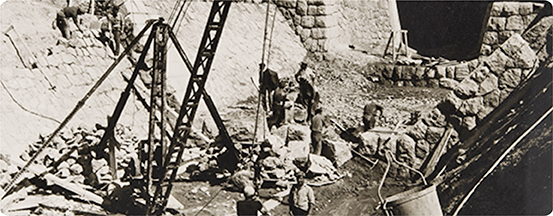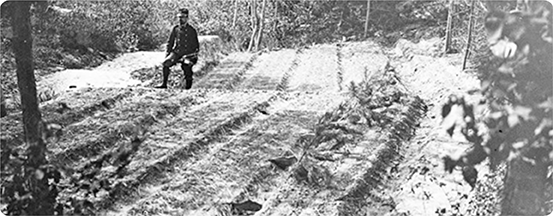Silencing a torrent
Since the 1860s, government departments have been working to secure natural and human habitats threatened by erosion and mountain torrents. Civil engineering and environmental engineering techniques are used. They range from masonry work to grass seeding to reforestation, and this is done from top to bottom.

But what does it mean to “silence a torrent”?
A torrent is a watercourse that tends to transport a lot of solid material (sediment, wood) during its floods, creating more damage than a stream that floods its surroundings mainly with water. It is the slope of torrents that enables them to transport the materials made available by geology and mobilised during floods. If its banks erode and a channel concentrates the run-off, there is a major risk of torrential flooding or debris flows.
Since 1860, the mountain land restoration services (RTM) have been working to reduce these hazards* and hence the losses suffered by people living in mountainous areas.
Silencing a torrent means reducing the production as well as the transport of sediment right from the source, at the headwater area of the river basin.

Infographic: watershed of a torrent, In: "risques naturels en montagne" (Natural Mountain Hazards. In French), Florence Naaim and Didier Richard (editorial coordination) Quae 2015 (https://www.quae.com/produit/1328/9782759223886/les-risques-naturels-en-montagne).
The engineers and foresters at the École nationale des Eaux et Forêts, the French National School of Forestry have embarked on major works on more than a thousand torrents, based initially on the work of engineers from the Ecole des Ponts et Chaussées such as Jean-Antoine Fabre and Alexandre Surell. As early as 1841, Surell recommended launching a highly ambitious campaign to reforest the mountains in order to restore the very degraded state of the vegetation, the only operation capable of silencing the torrents. This reforestation would be facilitated by the construction of check dams to stabilise the banks, at least until the vegetation reached maturity.
* *Hazard: a phenomenon that is more or less likely to occur in a given area, characterised by its location, intensity, extent, frequency and the degree of probability associated with it. It may: (i) be "natural" (like floods, earthquakes, volcanic eruptions, cyclones and avalanches); (ii) be linked to technology (for example factory explosions and oil tankers sinking); (iii) be the result of violent social relations (such as wars and terrorism); or (iv) come from other living species (epidemics). Source : Caquet et al.(2021).
Torrent families
Not all torrents have the same characteristics, though:
- Torrents with lightly laden flow are fed by gullying processes, and are treated with a mixture of civil engineering and environmental engineering;
- Flashy slide-fed torrents are fed by landslides from cliffs and are areas that are impossible to reforest;
- Glacial torrents, where the upper part of the basin is occupied by moraines and glaciers, are at too high altitudes to be reforested.
These last two types of torrent “to be silenced” are therefore treated with retention and stabilisation dams and engineered structures such as tunnels to divert flows away from the main sources of sediment, namely landslides and rockfalls.
Civil and environmental engineering
The three main types of structure or development implemented are:
- Dams and weirs, civil engineering structures generally located at the headwater area of a river basin, providing indirect protection by combating erosion at source;
- live-brush check dams (wattle and fascine works), grass seeding and reforestation, biological engineering works that also provide indirect protection;
- dykes, groynes, dredging of riverbeds and canals, civil engineering works located near buildings, networks and crops, providing direct protection by guiding and diverting run-off from vulnerable areas.
And today at INRAE
The Draix-Bleone observatory is located in the French South Alps, in the Bleone valley upstream of Digne. This observatory was set up by IRSTEA (now INRAE) in 1983 to study hydrological and erosive processes in mountain badland terrain developed on Jurassic black marls that are very sensitive to erosion, scarcely vegetated and deeply incised (also called “Terres Noires” or black lands.)
Some of the scientific issues addressed concern water fluxes and their pathways through the catchments, developing innovative geophysical methods to measure them, as well as erosion and transport processes on hillslopes and in the streams.
Bibliography
Demontzey, P. (1882). Traité pratique du reboisement et du gazonnement des montagnes (Practical treatise on mountain reforestation and turfing. In French), Rothschild J. (ed.), 528 p.
Demontzey, P. (1882). Le reboisement des montagnes (Reforestation of the mountains. In French). La nature, n°496. p.151-155, p. 182-186, p.215-218, p.260-263.
Bénardeau, F., & Cuny, E. (1889). La science forestière illustrée (Illustrated forestry science. In French). Ministère de l'agriculture service central, First volume, Part 4.
Thiéry, E. (1891). Restauration des montagnes, correction des torrents, reboisement (Mountain restoration, torrent correction, reforestation. In French). Baudry (Paris), 413 p.
Bernard, C. (1927). Cours de restauration des montagnes (Mountain restoration course. In French). ENEF. First volume, text and plates. (Document available winter 2023-2024)
Bernard, C. (1927). Cours de restauration des montagnes. (Mountain restoration course. In French). ENEF. 2nd volume, text and plates. (Document available winter 2023-2024).
Clave, A. (1969). Rapport VI.3. Le rôle de la restauration des terrains en montagne dans la protection contre les inondations (The role of mountain land restoration in flood protection. In French), in La prévision des crues et la protection contre les inondations (Flood forecasting and protection. In French) . Dixièmes journées de l'hydraulique, Paris, 5, 6 et 7 juin 1968. Tome 6,.
Mathys, N., Brochot, S., & Meunier, M. (1996). L’érosion des Terres Noires dans les Alpes du sud: contribution à l’estimation des valeurs annuelles moyennes (bassins versants expérimentaux de Draix, Alpes de Haute Provence, France) (Erosion of the “Terres Noires” in the Southern Alps: Contribution to the estimation of mean annual values (experimental catchment areas of Draix, Alpes-de-haute-Provence, France. In French). Revue de géographie alpine, 84(2), 17-27.
Labonne, S., Rey, F., Girel, J., Evette, A. (2007). Historique des techniques de génie biologique appliquées aux cours d’eau (History of biological engineering techniques applied to watercourses. In French). Ingénieries eau-agriculture-territoires, 52, 37-48.
Cosandey, C., Lavabre, J., Martin, C., & Mathys, N. (2002). Conséquences de la forêt méditerranéenne sur les écoulements de crue Synthèse des recherches menées en France (Effects of Mediterranean forest on floods Synthesis of French studies. In French), La Houille Blanche, 88:3, 38-42.
Piton, G., Carladous, S., Recking, A., Tacnet, J. M., Liebault, F., Kuss, D., Queffelean, Y., & Marco, O. (2019). Fonctions des barrages de correction torrentielle (Functions of check dams in steep creeks. In French). Cybergeo: European Journal of Geography, Environnement, Nature, Paysage, document 896, DOI : https://doi.org/10.4000/cybergeo.32190
Piton, G., Carladous, S., Marco, O., Richard, D., Liébault, F. et al. (2019). Usage des ouvrages de correction torrentielle et plages de dépôt : origine, état des lieux, perspectives (Using check dams and open check dams in torrent control: origin, state of the art and perspectives. In French). La Houille Blanche - Revue internationale de l’eau, 2019 (1), 56-67.
Piton, G. (2022, June 5th). Check dams on torrents?, Encyclopedia of the Environment.
Text written by Pascale Hénaut (INRAE-DipSO).
Thanks to Guillaume Piton (Univ. Grenoble Alpes, INRAE, IGE) for his proofreading..
How to cite: Focus Agate: Putting out a torrent, Pascale Hénaut (INRAE-DipSO), may 2024. https://agate.inrae.fr/agate/en/content/focus





